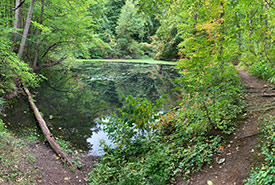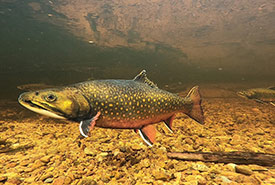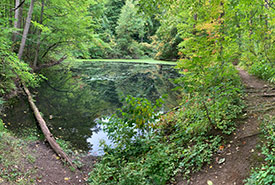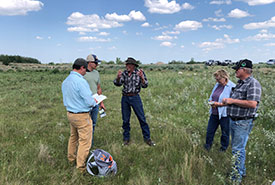NCC: Land Lines – Twelve Mile Creek: Niagara’s last remaining cold-water habitat

View of lower pond and adjacent embankment crest at Lathrop Nature Preserve, ON (Photo by Noel Boucher/ NCC)
In the urban landscape of Niagara, Ontario, lies a hidden gem: Twelve Mile Creek. This stream holds significant importance as the last remaining cold-water habitat in the region, serving as a critical lifeline for native species, including brook trout. Its conservation is paramount in protecting our natural heritage and its inhabiting species.
Nestled in the headwaters of the creek is the Nature Conservancy of Canada’s (NCC’s) Lathrop Nature Preserve — a nature retreat beloved by the Fonthill community and residents of the Niagara region. Since 2013, Trout Unlimited Canada (TUC) and Niagara College have joined efforts to enhance fish habitat within the watershed. Building on this partnership, NCC is actively engaged in plans to restore two ponds at the Lathrop Nature Preserve. The goal of the initiative is to enhance habitat connectivity, promote downstream water quality and increase trail safety. These restoration efforts aim to benefit a variety of aquatic species.
Brian Green, secretary of Trout Unlimited Canada’s Niagara Chapter, says “the Lathrop Preserve is a gem: a lush, forested tract intersected by hills and ravines, and home to a magnificent variety of Carolinian vegetation and many species of birds and animals. It is even more remarkable for the fact that it lies right in the heart of Fonthill. While the preserve appears to be completely natural, much of its topography has been shaped by man.”
The health of Twelve Mile Creek faces threats from human activity, such as development and climate change. As standing water in the ponds warms up and flows into the creek, the creek temperature rises. Unlike their introduced counterparts, brook trout requires pristine conditions to thrive. Just a few degrees disrupts the natural flow of the creek.

Mature male brook trout (Photo by Jacob Bowman via iNaturalist, CC BY-NC 4.0 Deed)
Brian says that brook trout, with its scientific name being Salvelinus fontinalis, which is Latin for “living in springs,” are not actually trout. They, like lake trout and Arctic char, are from the char family.
By removing barriers and reintroducing cold groundwater to the headwaters of the preserve, NCC and its partners aim to revitalize habitat for aquatic life on the preserve and downstream of Twelve Mile Creek.
As stewards of the environment, it is crucial that we unite to support these conservation efforts. By raising awareness and promoting community engagement, we can ensure a more sustainable future for Twelve Mile Creek and its inhabitants.
“One of the most useful criteria for judging whether a stream may be classed as cold water is the presence (or absence) of trout, since trout need cold, clear, oxygenated, clean water to survive,” says Brian.
Curious to learn more about how you can contribute to the protection of this delicate ecosystem? Explore the Lathrop Nature Preserve pond restoration project page and join us in improving the health of Twelve Mile Creek for generations to come.
To learn more about other restoration work occurring in the Twelve Mile Creek Watershed, visit healthytwelvemilecreek.ca.
Find out more about the initiative on the Lathrop pond restoration project page.




